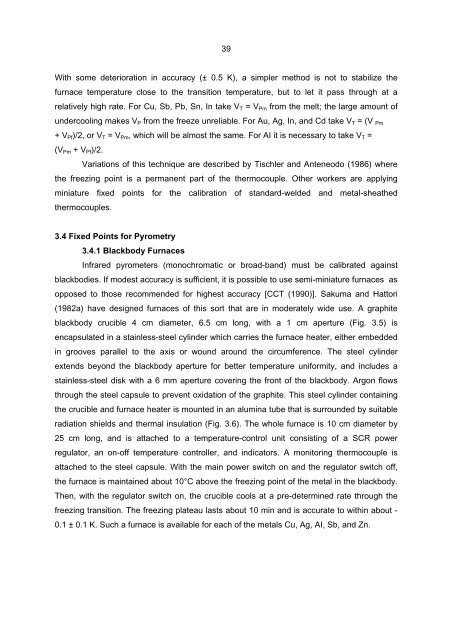techniques for approximating the international temperature ... - BIPM
techniques for approximating the international temperature ... - BIPM
techniques for approximating the international temperature ... - BIPM
You also want an ePaper? Increase the reach of your titles
YUMPU automatically turns print PDFs into web optimized ePapers that Google loves.
39<br />
With some deterioration in accuracy (± 0.5 K), a simpler method is not to stabilize <strong>the</strong><br />
furnace <strong>temperature</strong> close to <strong>the</strong> transition <strong>temperature</strong>, but to let it pass through at a<br />
relatively high rate. For Cu, Sb, Pb, Sn, In take VT = VPm from <strong>the</strong> melt; <strong>the</strong> large amount of<br />
undercooling makes VP from <strong>the</strong> freeze unreliable. For Au, Ag, In, and Cd take VT = (V Pm<br />
+ VPf)/2, or VT = VPm, which will be almost <strong>the</strong> same. For AI it is necessary to take VT =<br />
(VPm + VPf)/2.<br />
Variations of this technique are described by Tischler and Anteneodo (1986) where<br />
<strong>the</strong> freezing point is a permanent part of <strong>the</strong> <strong>the</strong>rmocouple. O<strong>the</strong>r workers are applying<br />
miniature fixed points <strong>for</strong> <strong>the</strong> calibration of standard-welded and metal-shea<strong>the</strong>d<br />
<strong>the</strong>rmocouples.<br />
3.4 Fixed Points <strong>for</strong> Pyrometry<br />
3.4.1 Blackbody Furnaces<br />
Infrared pyrometers (monochromatic or broad-band) must be calibrated against<br />
blackbodies. If modest accuracy is sufficient, it is possible to use semi-miniature furnaces as<br />
opposed to those recommended <strong>for</strong> highest accuracy [CCT (1990)]. Sakuma and Hattori<br />
(1982a) have designed furnaces of this sort that are in moderately wide use. A graphite<br />
blackbody crucible 4 cm diameter, 6.5 cm long, with a 1 cm aperture (Fig. 3.5) is<br />
encapsulated in a stainless-steel cylinder which carries <strong>the</strong> furnace heater, ei<strong>the</strong>r embedded<br />
in grooves parallel to <strong>the</strong> axis or wound around <strong>the</strong> circumference. The steel cylinder<br />
extends beyond <strong>the</strong> blackbody aperture <strong>for</strong> better <strong>temperature</strong> uni<strong>for</strong>mity, and includes a<br />
stainless-steel disk with a 6 mm aperture covering <strong>the</strong> front of <strong>the</strong> blackbody. Argon flows<br />
through <strong>the</strong> steel capsule to prevent oxidation of <strong>the</strong> graphite. This steel cylinder containing<br />
<strong>the</strong> crucible and furnace heater is mounted in an alumina tube that is surrounded by suitable<br />
radiation shields and <strong>the</strong>rmal insulation (Fig. 3.6). The whole furnace is 10 cm diameter by<br />
25 cm long, and is attached to a <strong>temperature</strong>-control unit consisting of a SCR power<br />
regulator, an on-off <strong>temperature</strong> controller, and indicators. A monitoring <strong>the</strong>rmocouple is<br />
attached to <strong>the</strong> steel capsule. With <strong>the</strong> main power switch on and <strong>the</strong> regulator switch off,<br />
<strong>the</strong> furnace is maintained about 10°C above <strong>the</strong> freezing point of <strong>the</strong> metal in <strong>the</strong> blackbody.<br />
Then, with <strong>the</strong> regulator switch on, <strong>the</strong> crucible cools at a pre-determined rate through <strong>the</strong><br />
freezing transition. The freezing plateau lasts about 10 min and is accurate to within about -<br />
0.1 ± 0.1 K. Such a furnace is available <strong>for</strong> each of <strong>the</strong> metals Cu, Ag, AI, Sb, and Zn.
















